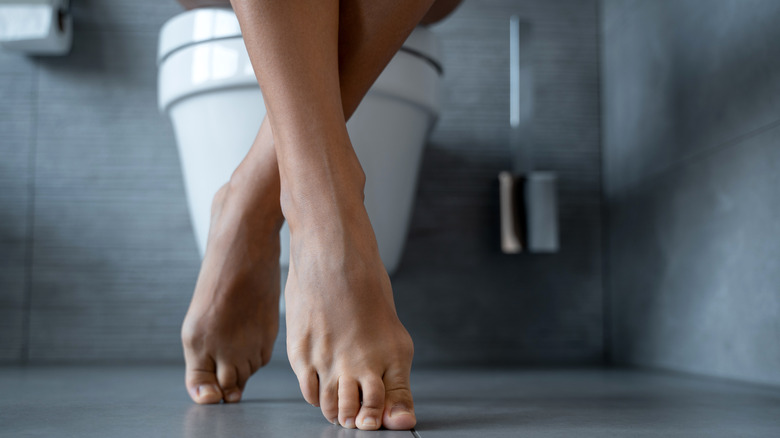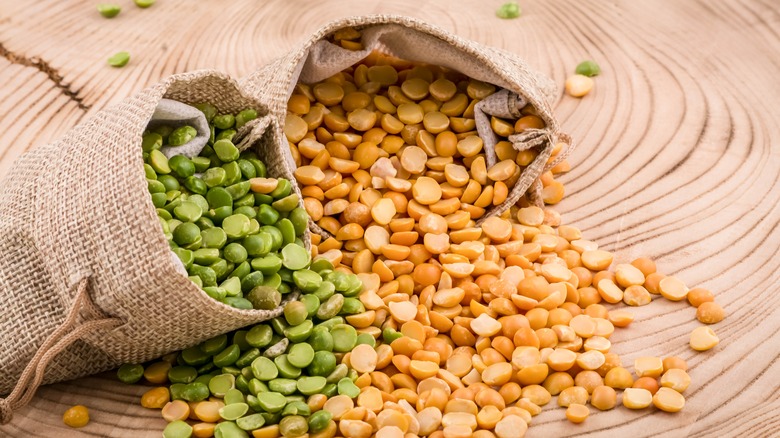The Best Carbohydrate To Help You Poop Isn't What You'd Expect
Carbohydrates usually get a bad rap. Although it's difficult to avoid them in your diet, having excessive carbohydrates can lead to weight gain, energy crashes, skin issues (acne), cavities, and sometimes, even constipation.
But according to registered dietitian Gaby McPherson (via Eating Well), there is a reason to reconsider carbs in your diet if you're constipated. This is mainly because of one carbohydrate that can actually aid you when you're "stuck" on the toilet seat. The food in question belongs to a group of carbohydrates called complex carbs, also referred to as the good kind of carbs. We're talking about split peas.
Split peas are a kind of legume. They've got the term "split" in them because they're, essentially, dried, peeled, and split in the middle. You can get split peas in the green and yellow varieties; the green kind is more sweet in nature, while the yellow split peas possess an earthy taste. Here's how this humble complex carb can help you poop.
Split peas are a rich source of fiber
You've probably read enough to know that fiber makes you poop. And split peas pack a punch when it comes to fiber: 1 cup contains as much as 43.5 grams of dietary fiber, per the U.S. Department of Agriculture. Split peas have both the soluble and insoluble kinds. Both of these kinds of fibers perform different functions when it comes to your bowel movements.
Soluble fiber adds bulk and softness to your poop by pulling water into it. When you are constipated, you're most often sitting on the toilet, wishing that your poop magically becomes pulpy enough to make its way out of you. This is where soluble fiber comes in. Insoluble fiber works by remaining relatively intact when passing through your digestive system. This also means that food will move along faster.
Additional poop-related benefits of split peas include their resistant starch content, per McPherson (via Eating Well). Resistant starches get their name for a reason: they refuse to break down into glucose. Your gut bacteria can be broadly defined as "good" and "bad" bacteria. What happens with split peas and other foods that contain resistant starch is that they ferment in your digestive system. They also become a food source for the "good" gut bacteria, which positively influences their health and volume. Your gut health, complete with bacterial diversity, is an important part of being regular, bathroom habits-wise.
How to consume split peas for their poop-related benefits
It's hard to escape the classic split pea soup when you search for recipes online. It's hearty, easy to make, and contains a load of nutrients that are good for you, not just poop-wise.
You'll typically need split peas (either the green or yellow variety, depending on what taste you're going for), water, a ham bone (optional), any vegetables you'd like to add, and seasoning of your choice. If you don't want the ham bone and want a vegan version, you can skip that step altogether or opt to throw in some croutons for texture. There are various versions of split pea soup, so you're bound to find something you like. If not, why not concoct one of your own? As long as you've got your split peas, the rest is pretty versatile, ingredients-wise. You can also throw this complex carbohydrate into salads and tortillas or enjoy them as dhal or hummus.
One vital thing to remember, however, is that not all poop problems are created equal. Split peas are considered high in FODMAPs (fermentable oligosaccharides, disaccharides, monosaccharides, and polyols). Because they aren't easily digestible in your system, they have the potential to create gas, bloating, and cramping in some people. The complex carb's lectin content could cause digestive discomfort too. People with digestive concerns like irritable bowel syndrome (IBS) and inflammatory bowel disease (IBD) may want to run this food by their healthcare provider before adding it to their diet.
Speaking of carbs, did you know that cutting cabs has an unexpected effect on your poop too?


